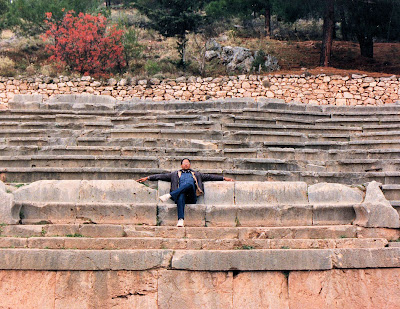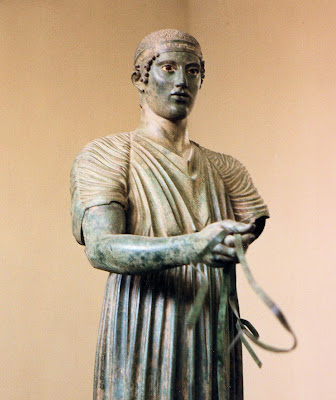 uins of Delphi was the fact that the entire complex had not only suffered earthquake damage but had lain buried under a small village since the Medieval ages. And they only agreed to move after another earthquake damaged their homes and were offered a whole new village to move to! By the late 19th century major excavations revealed much of what we were enjoying this crisp day on Mt. Parnassus at Delphi.
uins of Delphi was the fact that the entire complex had not only suffered earthquake damage but had lain buried under a small village since the Medieval ages. And they only agreed to move after another earthquake damaged their homes and were offered a whole new village to move to! By the late 19th century major excavations revealed much of what we were enjoying this crisp day on Mt. Parnassus at Delphi.The drive up from Athens was long and culminated in winding switchbacks as we crawled up the Pleistos Valley to get to Delphi. The winding Sacred Way greeted us for the on-foot portion of our day, leading us past the Treasury of Athens and the Sybil Rock to the Temple or Apollo at the heart of the complex. This temple dates from the 4th century B.C. and is the third in the series going back four hundred years before that. Not the largest temple but it's placement at the center of the complex and capping off the Sacred Way in addition to the views of the surrounding valley make it easily one of the most impressive.
We weren't done. Above the temple loomed the equally impressive bowl of
 an amphitheater, some 35 rows high and seating a solid 5,000 people. Still not finished, we continued on the trail ever higher up the mountain until a flat plain opened in front of us to reveal a thoroughly unexpected site in the shape of a full stadium. The Pythian Games were held here every four years but two years off from the Olympic Games so they would not overlap. Dating from the 5th century B.C. it stretched nearly 600 feet end to end and seated 6,500 in Romanesque stone bleachers thanks to renovations and other improvements by Herod Atticus.
an amphitheater, some 35 rows high and seating a solid 5,000 people. Still not finished, we continued on the trail ever higher up the mountain until a flat plain opened in front of us to reveal a thoroughly unexpected site in the shape of a full stadium. The Pythian Games were held here every four years but two years off from the Olympic Games so they would not overlap. Dating from the 5th century B.C. it stretched nearly 600 feet end to end and seated 6,500 in Romanesque stone bleachers thanks to renovations and other improvements by Herod Atticus.I had to do it. Yes, that's me clowning in the center of the royal box - more a stone sofa - giving the thumbs down in my best imperial pose.
Back at the main entrance to the complex and after deep reluctance to leave it all behind, the museum offered some choice delicacies of its own in the manner of a res
 tored sphinx and other statues discovered on the grounds. The signature piece is "The Charioteer," an unparalleled life-size depiction of a youth in bronze holding the reins to his horses while standing in a chariot after winning a race at the nearby stadium. Some hooves and other bits are nearby silhouetted by a drawing of what the entire piece once looked like but there is no taking the eyes away from the Charioteer himself. The inlaid eyes add haunting life to features that seem peeled from living flesh. It took a lot of cajoling from our tour guide to press on to the Tholos so we could get down the mountain before sunset for the journey home to Athens.
tored sphinx and other statues discovered on the grounds. The signature piece is "The Charioteer," an unparalleled life-size depiction of a youth in bronze holding the reins to his horses while standing in a chariot after winning a race at the nearby stadium. Some hooves and other bits are nearby silhouetted by a drawing of what the entire piece once looked like but there is no taking the eyes away from the Charioteer himself. The inlaid eyes add haunting life to features that seem peeled from living flesh. It took a lot of cajoling from our tour guide to press on to the Tholos so we could get down the mountain before sunset for the journey home to Athens.Roughly 50 feet in diameter with the posts for ten columns former an inner circle, only three of the twenty outer columns have been restored. Even then it is easy to see the concrete fill used to recreate the columns from among the strewn sections and rubble we threaded our way through for the best photo angles. After the view from on high within the main sanctuary the view from down low at the Tholos was no less mesmerizing as we looked up to imagine what the full glory of the temple, the theater, the treasuries and all those tunics must have looked like. As with every guided tour this
Sometimes when they say "restored" you want to see the completed building, roof, interior spaces, etc. In this place in Greece, Delphi, what is restored is the recognition of former grandeur, the feeling of total beauty, the resurrection of the very soul.
Gotta go
Nice blog!! The ruins Delphi is really worth a visit. As it ruined but then to it has restored many things which attracts visitors.
ReplyDelete